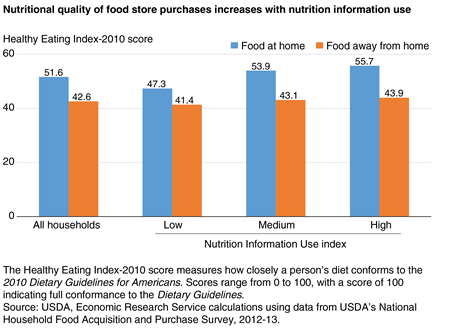Use of Nutrition Information and the Food Healthfulness Gap

Consumers have access to a variety of Government and private sources for nutrition information. A recent ERS study used data from USDA’s 2012-13 National Household Food Acquisition and Purchase Survey (FoodAPS) to explore whether consumers who say they are familiar with or use nutrition information (referred to subsequently as nutrition information use) actually make healthier food choices. The researchers found a positive relationship between nutrition information use and the nutritional quality of purchases from grocery and other food stores (food at home). However, for the average FoodAPS primary respondent, the nutritional quality of food purchased from fast-food places, sit-down restaurants, and other food-away-from-home sources did not vary significantly with his or her use of nutrition information.
FoodAPS is a nationally representative survey that collected unique and comprehensive information about household foods and beverages purchased or acquired for free over a 1-week period from grocery stores, eating places, and other sources such as schools, food pantries, and gardens. Researchers used a series of nine questions posed to FoodAPS households related to their awareness and use of various nutrition education initiatives to create a Nutrition Information Use index and used it to classify households into three information use categories: low users of nutrition information (39 percent of households), medium users of nutrition information (48 percent of households), and high users of nutrition information (13 percent of households).
The nutritional quality of food-at-home purchases by FoodAPS households was 21 percent higher than that of foods purchased from food-away-from-home sources that week, creating a “healthfulness gap” between food at home and food away from home. This gap widened with nutrition information use, rising from 14 percent among households with low nutrition information use to 25 percent among households with medium nutrition use to 27 percent for the high nutrition information users. The healthfulness gap increased with nutrition information use because the nutritional quality of food-at-home acquisitions grew with the level of a household’s nutrition information use, while the nutritional quality of food-away-from-home acquisitions remained relatively constant.
This finding is consistent with an “indulgence effect” wherein consumers—when eating out—often indulge themselves by selecting less healthy treats than they might when cooking meals at home. Another explanation for the healthfulness gap between food-at-home and food-away-from-home acquisitions may be that consumers were eating at restaurants that, at the time of the survey, did not have nutrition information available that might have been used to guide food selections.
The Association Between Nutrition Information Use and the Healthfulness of Food Acquisitions, by Eliana Zeballos and Tobenna D. Anekwe, ERS, April 2018


